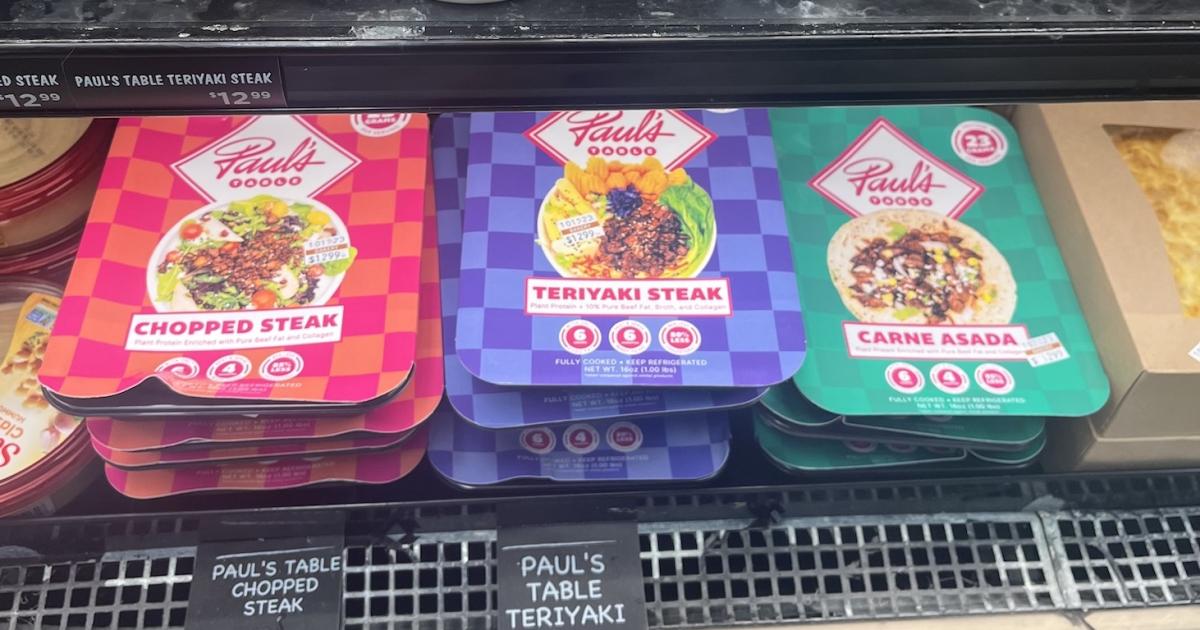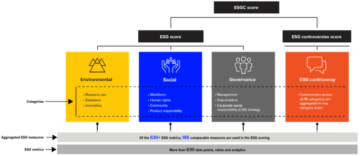
Last year, I wrote that lab-grown meat companies might have more success if they were ingredient providers for more convincing plant-based products, rather than chasing the dream of a completely cruelty-free T-bone steak on their own.
The same might be true of the alternative protein market. Instead of investing tons of money and time into a mushroom product that tastes, chews and nourishes exactly like beef, real meat might be the silver bullet for the alternative protein market.
“Blended meat” (also called hybrid meat) combines a small amount of fat and protein from traditional meat sources with a plant-based product to elevate the taste and mouthfeel of alternative proteins while keeping most of the emissions benefits of a non-meat food.
“If you really have the goal of reducing the number of animals who are used for food, hybridizing meat is a particularly effective way to do it,” said Paul Shapiro, CEO of The Better Meat Co.. His company is an ingredient startup that sells plant-protein products to be combined with traditional meat at big consumer packaged food companies.
In 2018, The World Resources Institute crunched the numbers: Swapping out 30 percent of beef for mushrooms in 10 billion burgers (the annual number of burgers Americans eat each year) would cut the carbon emissions equivalent of all the cars in San Diego County. It would also reduce the amount of irrigation water and agricultural land used by an area about the size of Maryland.
Vegans and vegetarians might balk, but in 2022, 94 percent of Americans were still meat eaters. As other countries get richer, their demands for meat are increasing. We need a product that appeals to them but with a reduced carbon impact.
In 2021, plant-based meat accounted for only 1.4 percent of all food and beverage sales in the U.S. The market has stalled without a lot of repeat purchasing. A blended meat product could reinvigorate the lagging industry.
“We’re pursuing a lasting and long-term solution to the meat consumption issue,” said Saba Fazeli, CEO of Paul’s Table, a blended meat startup based in Los Angeles selling direct-to-consumer and in grocers. “Especially when that consumer we’re talking about is already a meat eater.”
Don’t say blended or hybrid meat. It’s enhanced
I’ve already made a cardinal error by calling it “blended meat,” according to Better Meat’s Shapiro. “When you use the term blended meat, people typically think of meat that has been put into a blender. We talked about ‘enhanced meats.’” It’s not marketed as a less-meat product, it’s marketed as a meat product that’s better.
Better Meat’s collaboration with Perdue Farms was named Chicken Plus — a chicken nugget that’s 50 percent cauliflower, chickpeas and other plant proteins, available in 7,100 grocers. On the packaging of Paul’s Table’s array of products — carne asada, teriyaki steak and chopped steak — the label reads “plant protein enriched with pure beef fat and collagen.”
Because these products aren’t trying to capture the vegetarian market, these aren’t in the arguably oversaturated alternative meats section of a grocery store that’s already filled to the brim with new products. Instead, both companies are focusing on customers who prioritize health benefits but also want convenience. That’s why they’re strategically putting their products in the ready-made section.
We’re pursuing a lasting and long-term solution to the meat consumption issue.
“Our products are uniquely convenient. They take four to five minutes to heat up, are high protein, low fat, low carb and low cholesterol,” said the COO of Paul’s Table, Brice Klein. “And then they happen to be an alternative meat product.”
When I pulled out my green package of Paul’s Table’s carne asada to taste-test it, it was the end of a long weekend. Fleet Week had taken over San Francisco and my trek back to Oakland had resulted in 90 minutes of stop-and-go traffic on the bridge. On Sunday, I drove 50 minutes down to San Jose to hike with a friend and start planning a backpacking trip abroad.
By the time I was driving the 50 minutes back home with a dangerously low tank of gas and my head hurting from staring at trail maps and campground reservation systems, the thought that dinner was only a microwave away was a relief. In that moment, Klein was right. It was the convenience that sold me. The fact that if I squinted just right, maybe I was offsetting my driving emissions from that weekend by choosing the more sustainable option felt like something I’d tell myself next time climate guilt threatened to overtake me.
How low can you go?
Better Meat works with big consumer food brands to create products that are 30 to 50 percent plant protein. Its first product is a combination of plant proteins, fibers, fats and flavors, designed to seamlessly blend into animal meat. The company also offers a single ingredient made from mushroom mycoprotein called Rhiza. According to Shapiro, there is a big desire from companies for single-ingredient additives instead of a mixture of many kinds of plant proteins. Most of Better Meat’s products are ground meat varieties — burger, chicken nugget, crab cake, etc.
Paul’s Table is pushing the percentage even lower. Its products are only 10 percent beef. The company is picking the parts of the animal that contribute the most to taste and mouthfeel — fat and collagen.
“How little animal ingredients can we use to retain or achieve that sensory experience?” Fazeli said.
The company uses animal byproducts from the existing beef supply chain — beef broth and collagen. These ingredients are readily available, already have a steady supply chain and are extremely cheap. Klein asserts that in two years he believes Paul’s table will achieve price parity to equivalent meat products. The company is already in six grocery stores across the West with plans to scale aggressively this year.
So how did it taste in the tortilla with corn salsa and cabbage? Not as good as my local taco truck but indistinguishable from an at-home equivalent with 100 percent meat. On its own, it was still a bit too tender to truly fool me. But of all the alternative proteins I’ve tried, I’ll say this is the only one I’ve ever spooned straight out of the packet, no accompaniments needed.
- SEO Powered Content & PR Distribution. Get Amplified Today.
- PlatoData.Network Vertical Generative Ai. Empower Yourself. Access Here.
- PlatoAiStream. Web3 Intelligence. Knowledge Amplified. Access Here.
- PlatoESG. Carbon, CleanTech, Energy, Environment, Solar, Waste Management. Access Here.
- PlatoHealth. Biotech and Clinical Trials Intelligence. Access Here.
- Source: https://www.greenbiz.com/article/secret-ingredient-plant-based-meat-real-meat
- :has
- :is
- :not
- $UP
- 10
- 100
- 2018
- 2021
- 2022
- 30
- 50
- 7
- 90
- a
- About
- abroad
- According
- accounted
- Achieve
- across
- additives
- aggressively
- Agricultural
- All
- already
- also
- alternative
- Americans
- amount
- an
- and
- Angeles
- animal
- animals
- annual
- appeals
- appeared
- ARE
- AREA
- arguably
- Array
- article
- AS
- At
- available
- away
- back
- based
- BE
- Beef
- been
- believes
- benefits
- Better
- BEVERAGE
- Big
- Billion
- Bit
- Blend
- Blender
- both
- brands
- brice
- BRIDGE
- burger
- but
- by
- CAKE
- called
- calling
- CAN
- capture
- carbon
- carbon emissions
- Cardinal
- cars
- ceo
- chain
- cheap
- choosing
- Climate
- CO
- collaboration
- combination
- combined
- combines
- Companies
- company
- completely
- consumer
- consumption
- contribute
- convenience
- Convenient
- convincing
- coo
- could
- countries
- county
- create
- Customers
- Cut
- demands
- designed
- desire
- DID
- Diego
- Dinner
- do
- down
- dream
- driving
- each
- eat
- Effective
- ELEVATE
- Emissions
- end
- enriched
- Equivalent
- error
- especially
- etc
- Ether (ETH)
- Even
- EVER
- Every
- exactly
- existing
- experience
- extremely
- fact
- Farms
- Fat
- felt
- fibers
- filled
- First
- five
- FLEET
- focusing
- food
- For
- four
- Francisco
- friend
- from
- GAS
- get
- Go
- goal
- good
- Green
- grocery
- Ground
- had
- happen
- Have
- he
- head
- Health
- High
- Hike
- his
- Home
- How
- HTTPS
- Hybrid
- i
- I’LL
- if
- Impact
- in
- industry
- ingredient
- ingredients
- instead
- Institute
- into
- investing
- issue
- IT
- ITS
- jpg
- just
- keeping
- Label
- lagging
- Land
- lasting
- like
- little
- local
- Long
- long-term
- los
- Los Angeles
- Lot
- Low
- lower
- made
- many
- Maps
- Market
- Maryland
- maybe
- me
- Meat
- might
- minutes
- mixture
- moment
- money
- more
- most
- my
- myself
- Named
- Need
- needed
- New
- new products
- news
- next
- no
- node
- number
- numbers
- Oakland
- of
- Offers
- offsetting
- on
- ONE
- only
- Option
- or
- originally
- Other
- our
- out
- over
- own
- package
- packaged
- packaging
- parity
- part
- particularly
- parts
- Paul
- People
- percent
- percentage
- planning
- plans
- plant
- plato
- Plato Data Intelligence
- PlatoData
- price
- Prioritize
- Product
- Products
- Protein
- Proteins
- providers
- pursuing
- Pushing
- put
- Putting
- rather
- RE
- readily
- ready-made
- real
- really
- reduce
- Reduced
- reducing
- relief
- reservation
- Resources
- resulted
- retain
- right
- s
- Said
- sales
- same
- San
- San Diego
- San Francisco
- San Jose
- say
- Scale
- seamlessly
- Secret
- Section
- Selling
- Sells
- Silver
- single
- SIX
- Size
- small
- sold
- solution
- something
- Sources
- start
- startup
- steady
- Still
- store
- stores
- straight
- Strategically
- subscribe
- success
- sunday
- supply
- supply chain
- Sustainability
- sustainable
- swapping
- Systems
- table
- Take
- taken
- talking
- tank
- taste
- tell
- Tender
- term
- than
- that
- The
- The West
- the world
- their
- Them
- then
- There.
- These
- they
- Think
- this
- this year
- thought
- thursday
- time
- to
- tons
- too
- traditional
- traffic
- trail
- tried
- trip
- truck
- true
- truly
- trying
- two
- typically
- u.s.
- uniquely
- use
- used
- uses
- want
- was
- Water
- Way..
- we
- week
- weekend
- were
- West
- when
- while
- WHO
- why
- will
- with
- without
- works
- world
- would
- year
- years
- you
- Your
- zephyrnet









